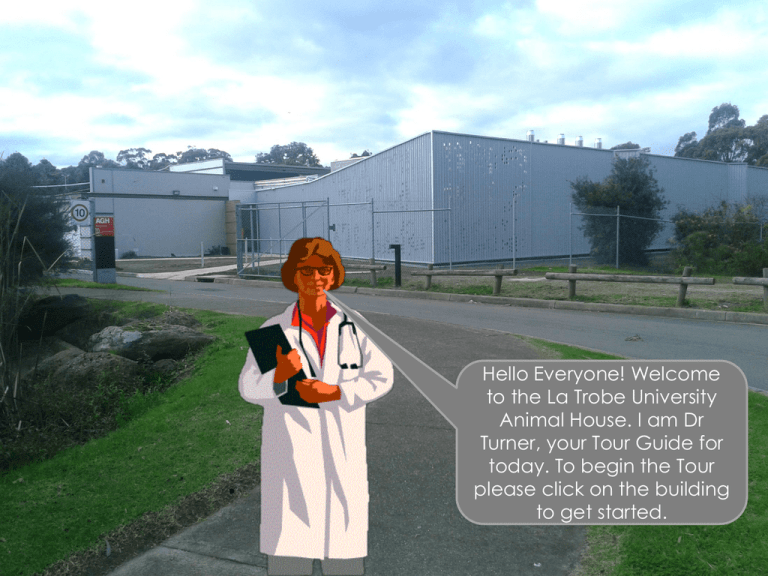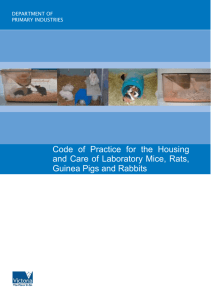Presentation1
advertisement

Hello Everyone! Welcome to the La Trobe University Animal House. I am Dr Turner, your Tour Guide for today. To begin the Tour please click on the building to get started. Professors Offices This is our Reception, Click on the laboratory door to begin the Tour through the Animal House or click on the Professors Offices door to talk to the professors about Animal Testing. If you ever want to come back to the reception press the Exit Button. If you just want to go back to the previous slide press the back button. Lets Begin! EXIT Animal Laboratory Professor N.J Hoogenraad EXIT Click on a door to enter a professors room. Professor A.J Simpson BACK EXIT Ethics Animal Rights Reliability This is Professor Simpson, He says feel free to use his books for information, just click on the one you want to read. Professor Simpson Ethics of Animal Testing There has been an on going debate about whether animals should be used to assist in medical research or not. There are many different points of view which can be categorised into for and against. For: within the category of for the opinions vary, some people believe that animals are just a resource for research and are meant to be exploited, but others believe that animals should be used because it is one of the best ways to develop human knowledge, but that they should be treated well and put through as little pain as possible. Research has shown that some animals in the animal house can live up to almost twice the age that they would in the wild. It can be argued that although it puts animals in harms way it is for the greater good, and eventually the human race will have the right alternatives that will make animal testing completely unnecessary. BACK Ethics of Animal Testing Against: people who are against animal testing can go to extremes to promote the injustice of it. It is heavily argued that animals should have rights too and do not deserve to be locked up in cages, and they use things such as the media to take the law into their own hands and try to free animals by protesting. Although these people have the animals best interests at heart they are not really thinking about how it will effect our population in the future. What animal protesters don’t seem to realize is how necessary it is to improve the lives of the human race, and at the same time we also learn things about the animals that are being tested on. The most reasonable opinion is that animal testing should be allowed as long as the animals are kept in a good, healthy condition and put through as little pain as possible. BACK BACK Pros and Cons List Pros: - Animal testing is a very good way to discover new medicine and cures to diseases - Saves human lives - Doesn’t always effect the animals - Sometimes they live a longer life in the cages than in the wild - They can be treated well - They help to create a better world Cons: - It costs a lot to care for the animals - Not fair on the animals - It Could effect the environment - They are not aloud to run around outside their cages - An animals body is different to humans therefore it might not be reliable - Not all animals are treated well BACK Ethics of Animal Testing In 1997 Dr Jay Vacanti and his team grew an ear on the back of a mouse Reliability of Animal Testing Animal testing is one of the most reliable sources of research for human health, however as technology has become more advanced, alternate methods to animal testing have become a more reliable source for research. Although it can not always be reliable animal testing is still extremely necessary for the research of human health. This is because it can be used in most areas of research to do with human health, whereas alternatives will only cover a small amount of research On human health. However to be considered reliable animal tested products have to be tested hundreds of times before it will be ready to try on humans, and even then there is not a one hundred per cent chance that the product will work. It is hard to tell whether the product will be successful and not harmful to humans, because an animals body is different to a human one. This is one of the main Reasons that some people BACK Reliability of Animal Testing consider animal testing an unreliable method of research. But scientists can do things such as manipulate the genes of an animal to give it a replica of a human disease such as diabetes, which can make their BACK research accurate enough to get a good idea of how their product will effect the human body. Animal Rights Many people and species of animals live and share a home on planet Earth, so the question is raised, why do humans have rights and animals don’t. people all over the world believe that animals deserve to have rights. Animal rights groups say that animals should have the same rights as humans to have a free life, without the worry of having to be tested on, and are trying to come up with new ways to put pressure on the government to take action on this issue. However other people believe that animals shouldn’t have rights because they are not as intelligent as humans. Now days animals still don’t have rights, but the animal rights campaigners try to get their message across by using the media. They hope to get enough followers so that eventually politicians will be forced into making laws about keeping animals safe. BACK Animal Rights Which will eventually result in no animal testing, so that scientists will have to find new alternatives that work just as well in order to keep the human race healthy. BACK BACK EXIT Please Click on a book you would like to read. Alternatives to Animal Testing Using Animal Testing to Benefit Human Health Legal Aspects of Animal Testing Alternatives to Animal Testing Introduction to Animal Testing Although animal testing can be beneficial when it comes to human health, it is often deemed unacceptable if the process causes harm to the animal. So, although many methods of animal testing are prohibited from being used nowadays, there are many other alternatives that are equally effective. These include: Human Skin and Tissue Testing One of the common alternatives to animal testing is human tissue testing. Rather than disrupting the natural life routine of an animal, technicians are able to test drugs on human tissue instead. The effect of the drug is then recorded, and gives the scientists accurate data . Eye Testing Alternative Instead of testing drugs on live rabbits eyes, scientists are now able to use chicken eyes from slaughtered meat and meat companies as an alternative. Pictured Left Caption: Drug research on human tissue Back Alternatives to Animal Testing Virtual Laboratory Mouse This alternative to animal testing is one that has very recently been brought into account but still has some further development to be completed. Instead of using live animals to test drugs on, technicians are now able to use Computer Generated Laboratory Mice to imitate and resemble that of a live rodent. This method involves using mice that have been genetically modified to research and investigate new medicines for different illnesses and more importantly (in this case) a cure for cancer. Test Tube Liver The test tube liver alternative is a recent method of experimentation that is used as a substitute to testing medicines on animal livers and guts. By using Nanotechnology to develop this method, scientists are promising these nano materials will bring forth new results and an improved performance. With this method, scientists are hoping to achieve a new cancer treatment in drugs however, it has to be used safely and carefully. Mice or Device? Back Alternatives to Animal Testing The Debate – Is animal testing wrong or right? For decades, there has been large debate about whether animals should be used for testing when it comes to benefiting human health. For many people, testing drugs on animals is highly unacceptable and should never be tolerated no matter what the situation is. However, when the life decision is based between an animal and a human being, although it’s unpleasant to some, human life should always be valued first and more than that of an animal. For more information on animal testing methods go to: Virtual Mouse: http://sciencebusiness.technewslit. com/?p=7834 General Alternatives: http://animaltestinginfo.weebly.co m/alternatives.html Test Tube Liver: http://www.manufacturingchemist. com/news/article_page/Test_tube_ gut_and_liver_alternative_to_anim al_testing/54976 Back Human Health Benefits of Testing Speed By using animals for testing, scientists are able to have their new procedures and medicines approved more quickly. Animals such as rodents are often and most commonly used for testing because they have short life spans. This means that they can go through multiple generations in just a few years and it makes being able to tell which medicines have long term side effects much easier. By having this aspect, it allows these methods and products to become popular and faster selling in a short amount of time, and in addition, this outcome could potentially save many lives. Back Reliability Since this type of medical testing has been performed on animals for several years, scientists are pretty much experts when it comes to animal testing and have a very clear idea on how it works. By knowing that this testing method is reliable, it ensures that products tested on animals (and that are successful) are going to be safe and beneficial when used on human beings. Pictured Left: Poliomyelitis Vaccine (Cure found using animal testing) Human Health Benefits of Testing Reduced Human Experimentation When a human uses an untested product, the levels of risk and danger to their bodies are quite significant and this can cause future problems. Animal testing provides a substantially beneficial level of tests that don’t put human health at risk and can therefore eliminate possible future problems. By ruling these dangers out, it ensures that fewer tests on humans can be performed and although animals don’t provide an exact result for drugs, they can help in the first stages of research. To find out more information on this topic go to: Benefits of Animal Testing | eHow.com Back Legal Aspects of Animal Testing Unlike many other countries in the world, using animals to test new drugs and medicines is legal in Australia. However the entire policy on animal testing is still very restricted and there are several laws that vary in different parts of Australia. Any form of animal testing that occurs anywhere in Australia must be approved by an educated and appropriate professional before it is performed on an animal. Hence, before anything is approved, it must meet a list of requirements and conditions prior to the commencement. Listed below are some of the legal aspects of animal testing for human diseases and illnesses: Animal Suffering Treatments As rodents such as mice and rats do not feel as much pain as other animals, they are not required to be given pain killers at any time and are also not protected by the law. Animals such as cats and rabbits however, are sensitive to pain and therefore providing them with pain killers is an essential requirement. Keeping Sheep When housing sheep in Australia for use in animal testing, they are required to be kept in modified pens. These pens are fitted with a straw bedding to provide a comfortable environment for the sheep. Continued on next page… Back Legal Aspects of Animal Testing It has a sufficient space that allows the animal to walk around freely and special walls that prevent the sheep from doing any damage to anything outside the pen. Lethality Tests Before any new type of testing on animals can be performed it has to be approved by the Animal Ethics Committee. Listed are the legalities that have to be confirmed: •The species of animal and how many of them there are •The type of procedure being performed •The justification for approval •Any options or adaptations being developed to replace or reduce the need to accomplish the lethality test Licensed Animal Testing Obviously, it is not up to anyone to be able to test drugs and products on animals. All industries in Victoria, Australia that wish to perform these acts require a special license that allows them to use animals for testing however, they are under strict guidelines. The Three R’s Today in Australia and all over the world, a principle called The Three R’s must be followed when using animals for scientific purposes in anyway. Continued on next page… Back Back Legal Aspects of Animal Testing The Three R’s (Replacement, Reduction, Refinement) are the three strategies that are used to achieve one’s goal while working on an experimental project that involves the use of animals. For more information about the legislation involving the use of animals go to: http://www.animalethics.org.au/ho me Pictured left: Rabbit with irritation in eyes after an eye test [Not in Australia] Did you know c that the black mice at La Trobe University bite REALLY hard? EXIT Rabbits Rats This is the room where we keep the animals that we research on. Click on the animal that you would like to learn about. Click on the notice bored to see some fun facts about these four animals. EXIT Back What conditions are they kept in? Why are rats used for testing? Click on which topic you would like to learn about! Rats Back Why are rats used for testing? Rats are mammals with nervous systems similar to our own. Little do we know that they feel pain, fear, loneliness, and joy just as we do. To communicate, rodents produce high pitched sounds that are not able to be heard by the human ear. Rats become emotionally attached to each other and love their families, and easily bond with guardians. Not only do rats express empathy but they also are quite protective, when another rat or human are in trouble they will put themselves in harms way to protect another. Rats are used for testing because in many ways they are very similar to humans and experimenters can test anything on them because they are not protected by the law like rabbits are. Back What conditions are rats kept in? • Ideally the height of cages should allow rats to stand on their hind legs and stretch up fully. • Rat cages should be made from plastic with wire mesh tops. • Bedding is required to cover the whole floor of the cage at a depth of 2cm. • Rats should be provided with a shelter. • Rats should only have up to 4 adults in a cage or 12 juvenile rats in a cage. • Rats should not be housed individually unless with permission from the animal ethics committee. • They need a nutritional diet . • They need a variation in diet . • Their nocturnal feeding patterns should be taken into account. • Rats should be familiarized with the people handling them. • Regular light cycles are needed. • They need to be housed in a temperature of between 20-26 degrees Celsius. • Should be provided with nesting materials. • All cages should be cleaned on a regular basis . EXIT Back Rabbits Click on which topic you would like to learn about! What conditions are rabbits kept in? Why are rabbits used for testing? Back Why are rabbits used for testing? Rabbits are commonly used in testing for cosmetics and other chemicals, where they are used to perform the Draize test. This test assesses drug toxicity and involves a substance being placed on the rabbit's eyes or skin, which are then observed for redness, irritation or any other damage. The test itself is a controversial one and is known to cause blindness and other types of damage in rabbits who undergo the procedure. It is also criticized harshly by animal welfare groups on the grounds that it causes excessive pain and suffering, without providing any real contribution to science given its frequent use for cosmetics testing. Another argument is that a rabbit's eyes are quite different from a human's eyes, which essentially renders the test inaccurate and unscientific. Currently, however, anesthetics are sometimes used and smaller doses of the substances in question are applied. In addition, modifications of the Draize test that are less harmful are now used. Also important is that if an in vitro test shows a substance to be harmful, it is not typically used in a Draize test because the result is anticipated as quite painful to the rabbit. Back What conditions are rabbits kept in? • A Big cage with Mesh surrounding the Rabbits. • Rabbit should not be left alone in a cage without another rabbit or they will become lonely. • Music from a radio being played in a rabbits room calms them. • There should always be bedding in the bottom of the cage. • Rabbits should be provided with a shelter. • They need a nutritional diet . • They need a variation in diet . • Rats should be familiarized with the people handling them. • Should be provided with nesting materials. • All cages should be cleaned on a regular basis . EXIT Back Fat tailed Dunnarts Click on which topic you would like to learn about! What are Fat tailed Dunnarts used for? What conditions are Fat tailed Dunnarts kept in? Back What are Fat tailed Dunnarts used for? Fat Tailed Dunnarts are not so much used for experimenting on, but more for research for their own benefit. The scientists explore things such as their breeding habits, to understand the way they live. The reason they are not used for testing at the moment is because we don’t know enough about them to make a reliable product that will work on humans. However in the future when we do know enough about them they will probably be used for testing. Back What conditions are Fat tailed Dunnarts kept in? • Ideally the height of cages should allow Fat Tailed Dunnarts to be able to stretch up fully. • Fat Tailed Dunnarts cages should be made from plastic with wire mesh tops. • Bedding is required to cover the whole floor of the cage at a depth of 2cm. • Fat Tailed Dunnarts should be provided with a shelter. • Fat Tailed Dunnarts should not be housed individually unless with permission from the animal ethics committee. • They need a nutritional diet . • They need a variation in diet . • Fat Tailed Dunnarts should be familiarized with the people handling them. • Should be provided with nesting materials. • All cages should be cleaned on a regular basis . EXIT Back What conditions are mice kept in? Why are mice used for testing? Click on which topic you would like to learn about! Mice Back Why are mice used for testing? Mice are mammals with nervous systems similar to our own. Mice and rats are very similar and sometimes feel the same things. Just as rats do mice feel pain, fear, loneliness, and joy. To communicate, rodents produce high pitched sounds that are not able to be heard by the human ear. Mice become emotionally attached to each other and love their families, and easily bond with guardians. Although mice are reasonably civil they do have quite a temper and do bite when handled incorrectly. Mice are used for testing because in many ways they are very similar to humans and experimenters can test anything on them because they are not protected by the law like rabbits are. Back What conditions are mice kept in? • Ideally the height of cages should allow mice to stand on their hind legs and stretch up fully. • Mice cages should be made from plastic with wire mesh tops. • Bedding is required to cover the whole floor of the cage at a depth of 2cm. • Mice should be provided with a shelter. • Mice should not be housed individually unless with permission from the animal ethics committee. • They need a nutritional diet . • They need a variation in diet . • Their nocturnal feeding patterns should be taken into account. • Mice should be familiarized with the people handling them. • Regular light cycles are needed. • Should be provided with nesting materials. • All cages should be cleaned on a regular basis . ANSWER TO THE QUESTION Reception Next So to Answer our overall question to what extent is it acceptable to use animal testing to improve human health our group would say that it is okay to use animal testing to improve human health if the animals are kept in a good environment, and handled with care, because without it human heath would not improve because there will be no new cures to diseases. Acknowledgments Dr Nick Hoogenraad Dr Christopher Adda Dr Mick Foley Dr Matthew Perugini Dr Adam Hart Mr Robert Ross Dr Michelle Spencer Bibliography: Websites: http://www.ahc.umn.edu/rar/ethics.html http://www.animalethics.org.au/__data/assets/pdf_file/0014/222512/housing-rats-scientificinstitutions.pdf http://www.latrobe.edu.au/directory/index.php http://www.peta.org/issues/animals-used-for-experimentation/default.aspx Interviews: Interview with Christopher Adda A tour around the Animal House Click me to finish the tour That’s the end of this tour I hope you enjoyed it, come back to visit soon. Click on me to leave.


![Historical_politcal_background_(intro)[1]](http://s2.studylib.net/store/data/005222460_1-479b8dcb7799e13bea2e28f4fa4bf82a-300x300.png)






